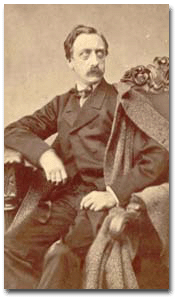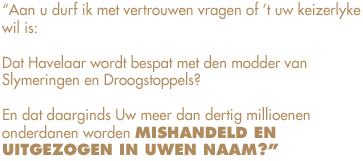


At the centre of Max Havelaar is the clash between the incompatible truths of the various narrators. First, there is the Amsterdam coffeebroker and first narrator Batavus Droogstoppel (Drystubble, or Dry-as-Dust), who is the caricature of everything that is “smug and narrow-minded” in Dutch society. He tells the reader that he happened to meet an old school friend, called ‘Sjaalman’ (‘Scarfman’), who is living in Amsterdam in reduced circumstances, after his stay in the colonies. This Sjaalman delivers a heavy bundle of papers on a wide variety of subjects (‘het pak van Sjaalman’) at Droogstoppel’s house, asking him to make a selection from his writings and have it published. The broker discovers that the parcel contains important information about the East Indies and, more importantly, about coffee. But Droogstoppel does not know how to select and arrange the material and asks a young German by the name of Stern, who has come to live with the Droogstoppel-family, to fulfil the task. Stern agrees to write up the Havelaar-story, assisted by Droogstoppel’s son Frits, and with the help of Sjaalman.
A portrait of Multatuli as ‘Sjaalman’ (Multatuli Museum, Amsterdam).
Through Stern and Sjaalman (the second and third narrators) the reader learns more about the misfortunes of the Assistant Resident of Lebak, the poetic and compassionate Max Havelaar, who fights against the indifferent but guilty bureaucratic system of colonial oppression in the Dutch East Indies. This gradually turns out to be the central story. Every now and then it is interrupted by Droogstoppel, whose view is in opposition with that of Stern and Sjaalman. Via Droogstoppel, we also read the sermon of Reverend Wawelaar (derived from “wawelen”, meaning “to twaddle”), which is full of hollow Biblical justifications of colonialism.
In the novel’s final pages, Multatuli himself takes up the pen, dismisses all his characters and casts aside the entire fictional edifice he has created. In so doing he confronts the reader with the central question of truth and with the problem of moral conscience. The novel ends with a direct appeal to the Dutch King, William the Third, ‘Emperor of the glorious realm of Insulinde, that coils round the Equator like a girdle of emerald’:
(Max Havelaar, of De Koffieveilingen der Nederlandsche Handelmaatschappij, ed. Annemarie Kets-Vree, 1998, p. 339)Do you want to read more about Multatuli and his Max Havelaar? Click >here for a bibliography of selected primary and secondary readings in Dutch, English and on the Internet.
Continue >here for an introduction to the Havelaar-fragment.

